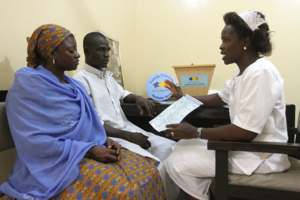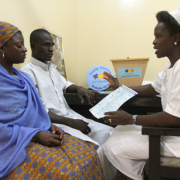Why Gender Is an Integral Part of Social and Behavior Change Communication Programs

A couple attends a family planning counseling session with a service provider in Nigeria’s central state of Kwara. © 2012 Akintunde Akinleye/NURHI, Courtesy of Photoshare
Gender equity was adopted as a Millennium Development Goal in 2000 and as a Sustainable Development Goal in 2015. It is recognized as an important determinant of health as well as a critical goal for global development.
Gender equity also plays a role in the success of social and behavior change communication (SBCC) programs. Whether promoting HIV treatment, family planning methods, or maternal and child health commodities, SBCC programs are often complicated by gender norms. These widely shared beliefs about male and female characteristics shape how society believes women or men should act.
When women and men do not have equitable decision-making power in households, contraception use, antenatal care seeking and even child nutrition can be compromised. When women are valued for their fertility, they may try to give birth at risky times or face community-level stigma. When men are valued for their dominance, they may have multiple sexual partners, refuse to wear condoms or, worse, engage in gender-based violence. When men are not welcome in health clinics, they are less likely to receive HIV/AIDS-related care. In cultures with gender preference, there are disparities in child immunization and nutrition. Poor health outcomes are also seen when there are gender-related restrictions on education, employment and autonomy.
Combating a harmful gender norm, or any other norm, is like swimming against the current. But SBCC is a powerful tool for shifting beliefs to support equity, an approach called gender transformation.
Some programs are specifically designed to challenge gender norms. The Johns Hopkins Center for Communication Programs (CCP), where HC3 is based, has developed gender transformative tools over the past decade that enable communities to directly address gender norms, including Arab Women Speak Out™, African Transformation™ and Tchova Tchova™ Historias de la Vida. These tools use community-based workshops to create an environment where gender norms can be critically assessed.
The principal innovators of African Transformation, Dr. Carol Underwood and Ms. Jane Brown, each have more than 20 years of experience in health communication and gender transformation. They know that the only people who can really redefine gender norms are the community members themselves.
“We don’t live there,” said Underwood in an interview. “It is community members who must live with the consequences. So we do not prescribe the norms for others. We simply catalyze a dialogue that allows the community to identify negative gender norms, those that hinder progress or even harm people, and reconstruct them into equitable gender norms.”
For example, African Transformation workshop participants are presented with role models from Africa who overcame gender-based challenges to improve their lives. They discuss their own situations and decide on community actions for gender transformation.
Altogether, Arab Women Speak Out, African Transformation and Tchova Tchova has been used in 14 countries across the Arab world and the African continent.
Most program managers, however, must address gender inequity indirectly while focusing on larger health issues. For example, family planning programs attempt to influence gender norms by encouraging couple communication. Yet, research shows that these programs are not inherently gender transformative; rather campaign strategies must explicitly integrate gender approaches to influence gender constructs.
HC3 is creating tools for program managers to do exactly that. In April, HC3 released the Integrating Gender into Social and Behavior Change Communication Implementation Kit, or Gender I-Kit. This I-Kit is a comprehensive learning and doing tool. Users learn concepts, theories and models on gender, behavior and health. They find tools to assess the gender-sensitivity of current SBCC programs. Then, they are guided through designing a gender transforming SBCC strategy.
For program managers working to increase demand for reproductive, maternal, newborn and child health (RMNCH) commodities, HC3 has a more specific guide. Addressing the Role of Gender in the Demand for RMNCH Commodities provides a diagnostic tool to determine how gender norms may be limiting these demands and four checklists to ensure gender is integrated from analysis to evaluation.
HC3’s Gender Resources








Leave a Reply
Want to join the discussion?Feel free to contribute!